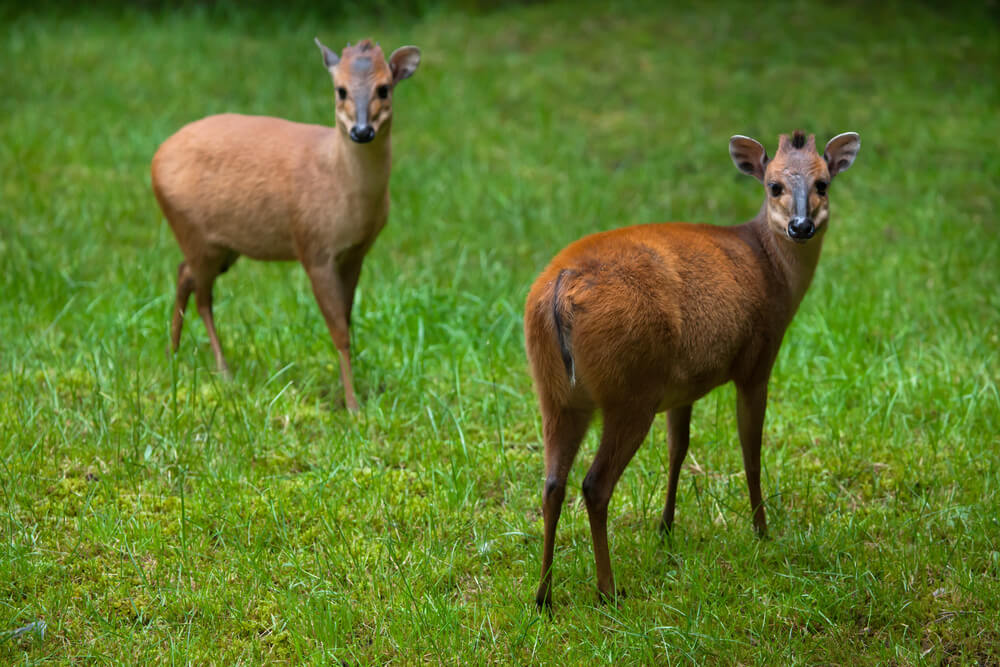When looking at hunting safari in South Africa, one usually imagines the big game hunting opportunities like lion, leopard, and rhino. But bigger might not always be better when hunting in South Africa; small game hunting safari adventures can give the hunter a chance to use different methods, challenge their game hunting skills (and patience), as well tackle some of the lesser sought-out species. Also known as pygmy antelopes, these antelopes provide a challenging South African game hunting safari!
A small antelope hunting safari in South Africa is available across the provinces with some species being widespread while others are endemic to specific regions. These tiny targets can prove to be an exciting game hunting possibility, taking the hunter off the beaten track and giving them a shot at a whole different set of trophies when hunting in South Africa.
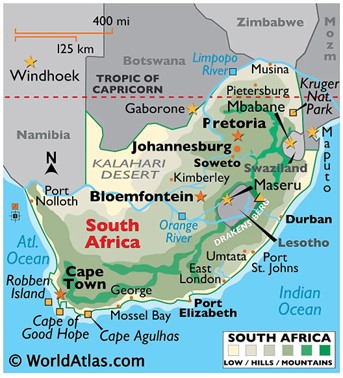
[DYNAMIC-BLOGTABLEOFCONTENT]
Why are these Game Hunting Targets known as Small Antelope?
The antelope people usually associate with game hunting in South Africa are targets such as the Springbok, Eland, Nyala, Impala, and Kudu; all species boasting impressive horns and weighing hundreds of pounds. However, the small antelopes covered in this blog barely scratch the surface in comparison. Small antelope typically clock in well under 50 pounds, measure less than 30 inches in height, and their horns usually don’t grow beyond 8–10 inches, depending on gender and species. This truly drives home the “small” stature of these game hunting antelope; but what they lack in height, they make up for in ability and camouflage, and are a tricky target for any hunting enthusiast.
Small Antelope Hunting in South Africa: The Species and the Safari Locations
Oribi (Ourebia ourebi)
In adulthood, these antelope reach 25 inches in height and a maximum weight of around 35 pounds, with females being the slightly bigger gender. They have red-brown coats with white underbellies and black tails, only males have horns. Their main predators are the lion, leopard, jackal, crocodile, and python as well as birds of prey.
When hunting in South Africa, look to the Eastern Cape, Mpumalanga, and KZN provinces, keeping your searches to grasslands, open plains, and light bush. The oribi are not big herd animals and usually go as pairs while sometimes forming groups of 7–10 members. Oribi freeze and give off a high whistle when in danger before running off, however, they like to stop and turn back, and this is usually the ideal time to take your shot.
Oribi hunting safari in South Africa is best planned early in the morning or just after sunset.
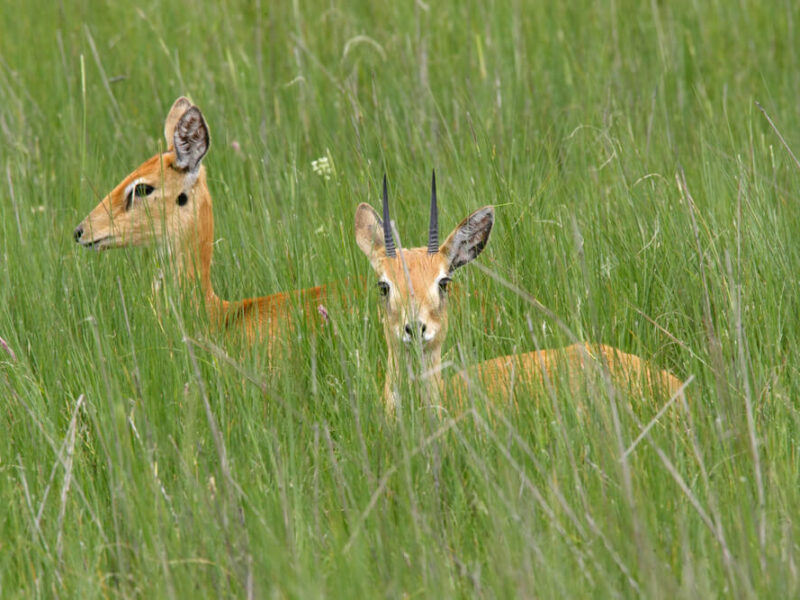
Suni (Neotragus moschatus)
Look to the Eastern Cape, Kwa Zulu Natal, and Mpumalanga if you want suni to be on your next hunting safari in South Africa. These game hunting antelope have a light brown to chestnut-colored pelage helping them to blend in seamlessly with their beloved brush habitat.
With an average height and weight of 15 inches and 12 pounds with males having horns of 3–5 inches, the suni is definitely a deserving member of the small antelope club; and like their club mates, the suni will run and then look back when fleeing danger as well as giving off a barking whistle sound alerting others to the danger.
Suni are another South Africa safari hunt small antelope that relies on their appearance as camouflage as their main defense tactic.
Sharpe’s Grysbok (Raphicerus sharpie)
A bit smaller than their cousin the Cape Grysbok, these small antelope clock in at about 15 pounds and 16–18 inches in height, with only the males having horns 2–3 inches long.
Sharpe’s grysbok can be found on a hunting safari in South Africa in the Northern Cape, KwaZulu-Natal Province, and Mpumalanga’s Lowveld region. They are known to run far distances when spooked and will sometimes take shelter in an abandoned burrow.
Wild dogs, hyenas, and the big cats are predators of this pint-sized antelope.
Klipspringer (Oreotragus oreotragus)
Known as the “goat of the rocks,” this small antelope can be found in South Africa safari hunt areas such as the Lebombo Mountains, Soutpansberg Mountain Range, and rocky mountainous areas around the Cape of Good Hope. Standing at around 23 inches and weighing around 28–30 pounds, the klipspringer has longer hind legs to assist with its rocky habitat. They have coarse coats ranging from grey to brown and even yellow.
Klipspringers are vigilant antelope and the rams very territorial; they give off a whistling grunt sound when alerting ewes and other herd members of danger.
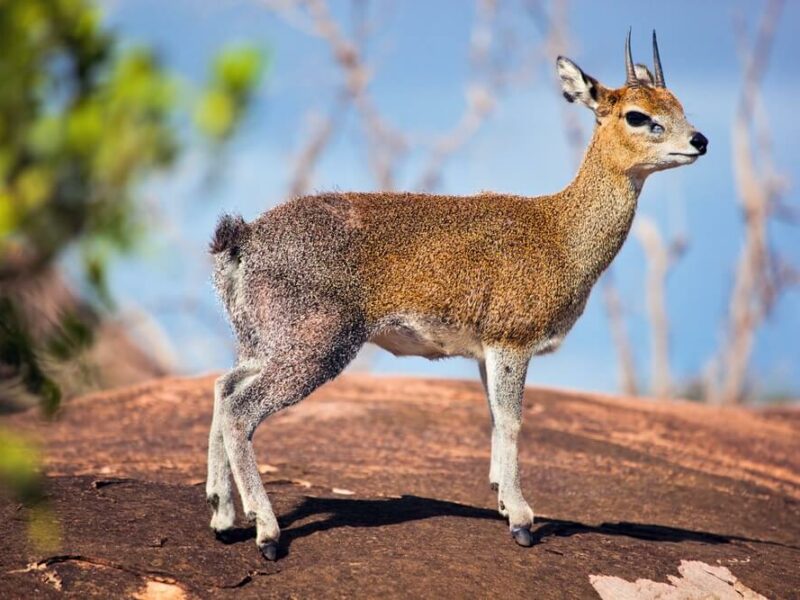
Cape Grysbok (Raphicerus melanotis)
A timid, shy, and solitary small antelope, the Cape grysbok has an average size of 20 inches/20 pounds; with the females being slightly larger and only the males baring upright yet slightly curved horns of 2–3 inches.
Cape grysbok hunting in South Africa is popular in the Western Cape Province, where they are endemic, as well as areas in the Eastern Cape where thick grassland and brush offer them the best protection. These antelope are most active at night and when running from a threat, they will zig zag erratically trying to throw off the predator.
Gray Duiker (Sylvicapra grimmia)
The most common of the duiker subspecies; the word “duiker” comes from the Afrikaans word meaning “to dive,” which accurately describes how this small game hunting antelope flees its predators, diving through the bush. They are gray–beige with a white underbelly and a black mark on the nose.
Unlike other small antelope found when hunting in South Africa, the gray duiker will also consume insects, fungi, caterpillars, baby birds, and even frogs. They are solitary antelope and can be most active early in the morning and late into the day. A grey duiker hunting safari in South Africa will commonly take place in the KwaZulu-Natal and Limpopo provinces where wooded areas, thick grasses, and even savanna-type areas are abundant.
Blue Duiker (Philantomba monticola)
The smallest of the 19 duiker species, the blue duiker comes in at around 10–11 inches in height and only weighs around 9 pounds. The horns on this tiny game hunting antelope measure from less than an inch to 4 inches, and their name originates from the blue-grey tinge of their coat.
A South Africa safari hunt for blue duiker will typically take place along the eastern coastline from the Umfolozi River area in KwaZulu-Natal right down through the Eastern Cape.
Red Duiker (Cephalophus natalensis)
Endemic to the Natal region, the KZN province is your best hunting safari destination for this small antelope. The Red duiker boasts an average height of around 18 inches and can weigh up to 35 pounds, and while both genders have horns, the males are typically twice as long as the females.
Steenbok (Raphicerus cempestris)
The most common of the small antelope species, the steenbok can be found during both the dawn and dusk periods but when close to human populations they can turn nocturnal. Steenbok typically have a height and weight of 20 inches/20 pounds with the male gender boasting horns of up to 7 inches.
The steenbok can be a challenging small antelope experience when hunting in South Africa as they have very good eyesight, hearing, and smell; but the patience and slowness of the stalk can be rewarded by the trophy.
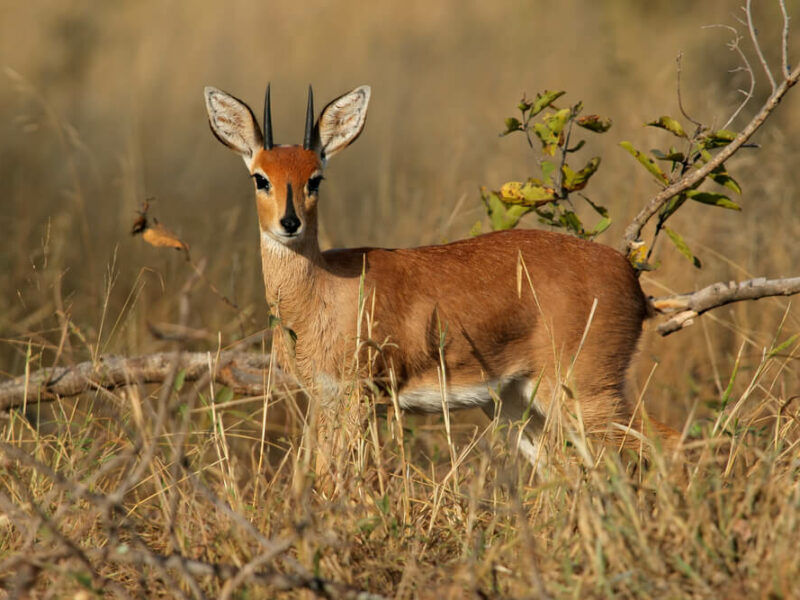
Methods for a Small Antelope Hunting Safari in South Africa and What Firepower to Pack
Oribi
A common trait amongst the small antelope is to run and look back, and the oribi is no different. A shot taken on an Oribi hunting safari can happen close or at a distance, and a .270 caliber is recommended as well as 120-grain bullets.
Sharpe’s Grysbok
This small antelope hunting safari in South Africa can be frustrating due to the antelope’s love of ducking into burrows and running for a decent distance before turning back. It’s preferred to make the shot from 40 yards or less to reduce the chance of losing the target; a shotgun with no. 5 or 6-steel shot is seen as perfect for the job.
Klipspringer
When on a hunting safari for an animal that loves being above ground level, the obvious method is to hunt from below. The hunter keeps their eyes up and opens for this lightning-quick, agile antelope. Like other small antelope, the klipspringer has a habit of running and looking back, and when this happens, a shot must be taken before the antelope disappears from view.
A .270 caliber full metal jacket ammunition is best so as not to cause too much damage if the hunter wishes to keep their trophy.
Cape Grysbok
This hunting safari will involve the walk-and-stalk method of finding the target, and due to the female being bigger, some hunters may be surprised when picking up their felled trophy. A medium-caliber rifle is suggested as the best firearm for the job.
Grey Duiker
A grey duiker hunting safari in South Africa demands quick reflexes and a keen eye. These small antelope are well camouflaged, and they possess a great sense of smell and incredible reflexes.
Solid point ammunition coupled with a rifle or small gauge shotgun are the best options for this hunting safari.
Blue Duiker
Blue duiker hunting in South Africa requires patience as these small antelope love to hide away in long grasses. Many times, you won’t know they’re there until they dart off. This is ideally when the hunter will take their shot, and it must be quick because the blue duiker can quickly disappear into the shrubbery.
A small gauge shotgun or rifle with solid point ammunition (to minimize trophy damage) is the best recommendation for a South Africa safari hunt for blue duiker.

Red Duiker
Spotting a red duiker spoor is the starting point for this game hunting jaunt; while to draw them out of the bush, mimicking animal noises is the way to go.
Most shots will happen quickly and at short range, so a shotgun is recommended for this type of hunting in South Africa.
Steenbok
A Steenbok hunting safari can be slow as the hunter stalks through the grasses, but can result in a fright when the steenbok suddenly appears before dashing off. These small antelope have great senses and thanks to their coloring, a brilliant ability to blend in with their surroundings.
Small gauge shotguns are recommended to as to avoid blasting the trophy to pieces.
Shot Placement Tips for a Small Antelope Hunting Safari in South Africa
On small antelope like the ones discussed here, a head/brain shot isn’t usually recommended due to the size of the target point and the quickness with which the antelope can move.
The popular shot placement for small antelope hunting safari is the broadside shot, this is due to the hunters being able to hit the heart and/or lungs for a faster, humane kill. The heart can be located just behind the shoulder, while the lungs will run from this area to just below the backbone.
Due to their alert natures, these small antelope may not always provide a full broadside shot opportunity, and instead, the hunter will need to take an angled shot known by the term quartering. These shots must be taken with precision, because if missed the bullet could miss the vital organs entirely or hit the stomach/liver, causing massive internal bleeding and a slower, more painful death.
For further information, check out our website section relating to Shot Placement For Small Antelopes.
The Challenges of Small Antelope Hunting in South Africa and How to Prepare for Them
While most big game hunting targets rely on one main sense, these small antelope are blessed with good abilities across sight, smell, and hearing senses. This factor means that they are always incredibly alert, and thanks to their speed skills, they can bound off at a moment’s notice.
Given the above, a hunter needs to work on stalking skills to ensure that they can be as deliberate and quiet as possible. Good tracking skills are also a must, as these antelope are gifted with built-in camouflage and can be incredibly difficult to spot if a hunter isn’t looking closely and intently.
Shot placement needs to be practiced when planning any hunting safari in South Africa, especially when going after these antelope. Fast shots that need the utmost accuracy are the order of the day and a hunter needs to be skilled and confident in their abilities to make the right call and the best shot.
A Hunting Safari in South Africa: Regulations and Requirements
- South Africa’s game hunting season is a year-round affair, but most hunting safari take place from April – September.
- Any foreign hunter hunting in South Africa is required to be in the company of a professional hunter.
- All hunters are required to apply for their hunting permits before the hunt.
- Certain provinces have allowances for game hunting at night or the use of artificial light; as well as whether or not hunting from a vehicle is permitted.
- The regulation time slot for a hunting safari in South Africa is from 30 minutes after sunrise until 30 minutes before sunset unless there is prior arrangement and permit.
- The availability or quota for any species can change without prior warning, so be sure to liaise with your outfitter or PH regarding this.
- Airlink and FlySafair airlines allow for traveling with firearms for hunting purposes; and these are limited to 2 hunting rifles, 1 shotgun (single or double), and 1 handgun. Ammunition regulations are airline standards according to international rules.
Find out more about hunting in South Africa in our blog entitled: “Hunting in South Africa: What, Where, and How Much?”
Author: A. Baker
